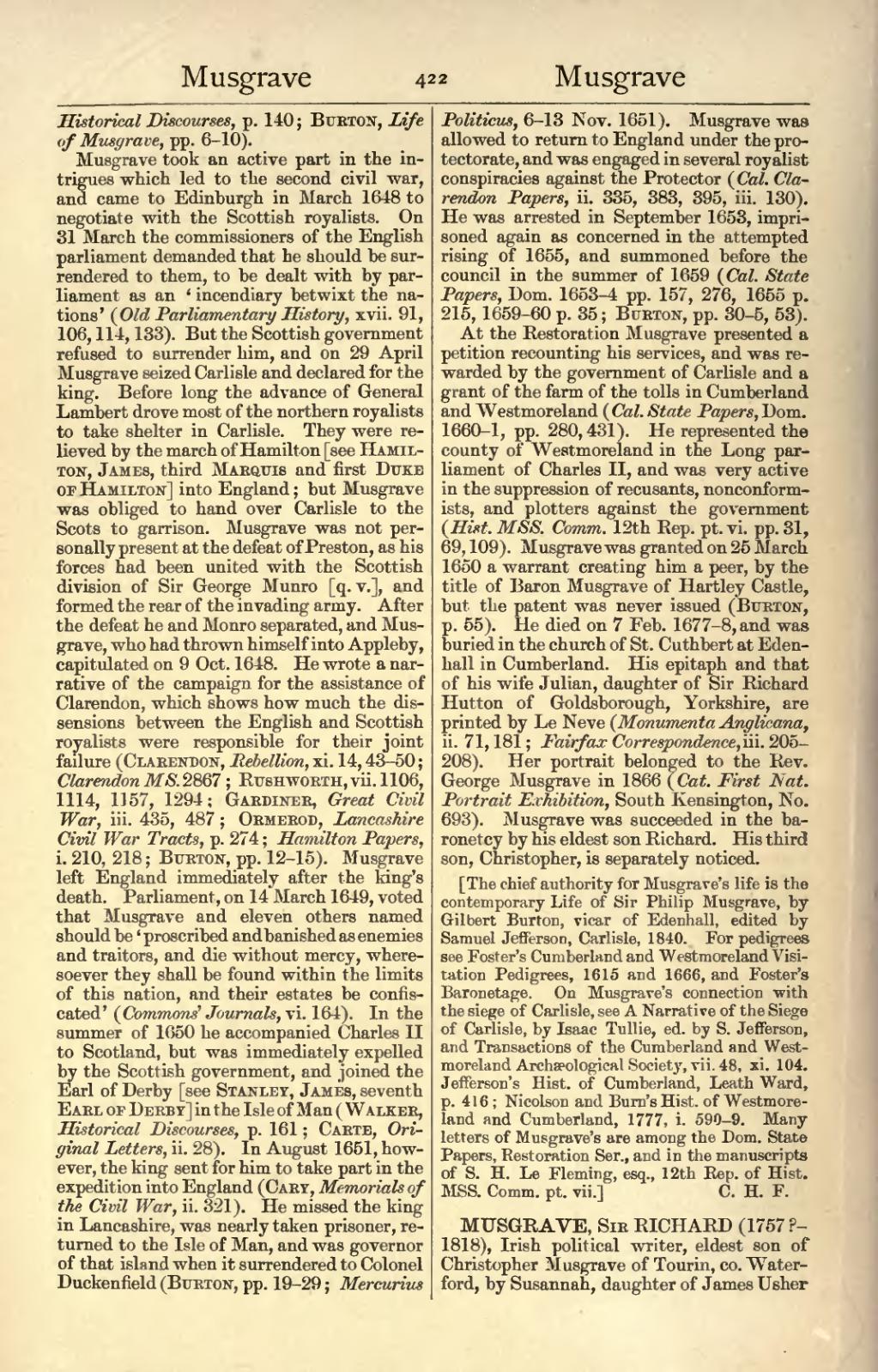Historical Discourses, p. 140; Burton, Life of Musgrave, pp. 6-10).
Musgrave took an active part in the intrigues which led to the second civil war, and came to Edinburgh in March 1648 to negotiate with the Scottish royalists. On 31 March the commissioners of the English parliament demanded that he should be surrendered to them, to be dealt with by parliament as an 'incendiary betwixt the nations' (Old Parliamentary History, xvii. 91, 106, 114, 133). But the Scottish government refused to surrender him, and on 29 April Musgrave seized Carlisle and declared for the king. Before long the advance of General Lambert drove most of the northern royalists to take shelter in Carlisle. They were relieved by the march of Hamilton [see Hamilton, James, third Marquis and first Duke of Hamilton] into England; but Musgrave was obliged to hand over Carlisle to the Scots to garrison. Musgrave was not personally present at the defeat of Preston, as his forces had been united with the Scottish division of Sir George Munro [q. v.], and formed the rear of the invading army. After the defeat he and Monro separated, and Musgrave, who had thrown himself into Appleby, capitulated on 9 Oct. 1648. He wrote a narrative of the campaign for the assistance of Clarendon, which shows how much the dissensions between the English and Scottish royalists were responsible for their joint failure (Clarendon, Rebellion, xi. 14, 43-50; Clarendon MS. 2867; Rushworth, vii. 1106, 1114, 1157, 1294; Gardiner, Great Civil War, iii. 435, 487; Ormerod, Lancashire Civil War Tracts, p. 274; Hamilton Papers, i. 210, 218; Burton, pp. 12-15). Musgrave left England immediately after the king's death. Parliament, on 14 March 1649, voted that Musgrave and eleven others named should be 'proscribed and banished as enemies and traitors, and die without mercy, wheresoever they shall be found within the limits of this nation, and their estates be confiscated' (Commons' Journals, vi. 164). In the summer of 1650 he accompanied Charles II to Scotland, but was immediately expelled by the Scottish government, and joined the Earl of Derby [see Stanley, James, seventh Earl of Derby] in the Isle of Man (Walker, Historical Discourses, p. 161; Carte, Original Letters, ii. 28). In August 1651, however, the king sent for him to take part in the expedition into England (Gary, Memorials of the Civil War, ii. 321). He missed the king in Lancashire, was nearly taken prisoner, returned to the Isle of Man, and was governor of that island when it surrendered to Colonel Duckenfield (Burton, pp. 19-29; Mercurius Politicus, 6-13 Nov. 1651). Musgrave was allowed to return to England under the protectorate, and was engaged in several royalist conspiracies against the Protector (Cal. Clarendon Papers, ii. 335, 383, 395, iii. 130). He was arrested in September 1653, imprisoned again as concerned in the attempted rising of 1655, and summoned before the council in the summer of 1659 (Cal. State Papers, Dom. 1653-4 pp. 157, 276, 1655 p. 215, 1659-60 p. 35; Burton, pp. 30-5, 53). At the Restoration Musgrave presented a petition recounting his services, and was rewarded by the government of Carlisle and a grant of the farm of the tolls in Cumberland and Westmoreland (Cal. State Papers, Dom. 1660-1, pp. 280,431). He represented the county of Westmoreland in the Long parliament of Charles II, and was very active in the suppression of recusants, nonconformists, and plotters against the government (Hist. MSS. Comm. 12th Rep. pt. vi. pp. 31, 69, 109). Musgrave was granted on 25 March 1650 a warrant creating him a peer, by the title of Baron Musgrave of Hartley Castle, but the patent was never issued (Burton, p. 55). He died on 7 Feb. 1677-8, and was buried in the church of St. Cuthbert at Edenhall in Cumberland. His epitaph and that of his wife Julian, daughter of Sir Richard Hutton of Goldsborough, Yorkshire, are printed by Le Neve (Monumenta Anglicana, ii. 71, 181; Fairfax Correspondence, iii. 205-208). Her portrait belonged to the Rev. George Musgrave in 1866 (Cat. First Nat. Portrait Exhibition, South Kensington, No. 693). Musgrave was succeeded in the baronetcy by his eldest son Richard. His third son, Christopher, is separately noticed.
[The chief authority for Musgrave's life is the contemporary Life of Sir Philip Musgrave, by Gilbert Burton, vicar of Edenhall, edited by Samuel Jefferson, Carlisle, 1840. For pedigrees see Foster's Cumberland and Westmoreland Visitation Pedigrees, 1615 and 1666, and Foster's Baronetage. On Musgrave's connection with the siege of Carlisle, see A Narrative of the Siege of Carlisle, by Isaac Tullie, ed. by S. Jefferson, and Transactions of the Cumberland and Westmoreland Archæological Society, vii. 48, xi. 104. Jefferson's Hist. of Cumberland, Leath Ward, p. 416; Nicolson and Burn's Hist. of Westmoreland and Cumberland, 1777, i. 590–9. Many letters of Musgrave's are among the Dom. State Papers, Restoration Ser., and in the manuscripts of S. H. Le Fleming, esq., 12th Rep. of Hist. MSS. Comm. pt. vii.]
MUSGRAVE, Sir RICHARD (1757?–1818), Irish political writer, eldest son of Christopher Musgrave of Tourin, co. Waterford, by Susannah, daughter of James Usher
